机械工程专业英语(施平版)Lesson 1
- 格式:ppt
- 大小:522.00 KB
- 文档页数:16
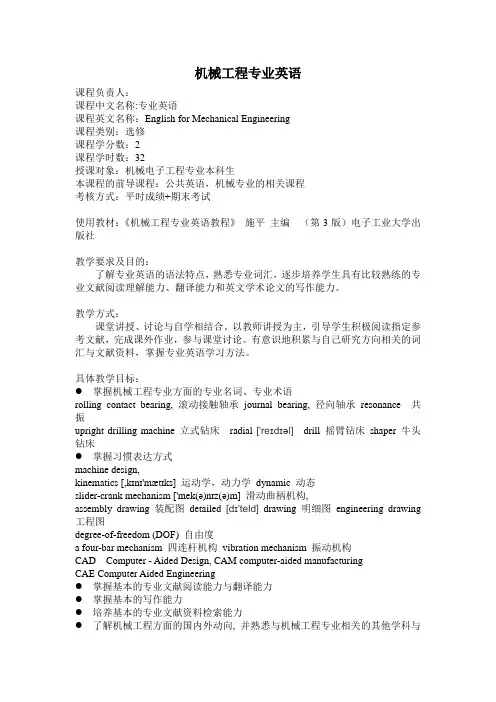
机械工程专业英语课程负责人:课程中文名称:专业英语课程英文名称:English for Mechanical Engineering课程类别:选修课程学分数:2课程学时数:32授课对象:机械电子工程专业本科生本课程的前导课程:公共英语,机械专业的相关课程考核方式:平时成绩+期末考试使用教材:《机械工程专业英语教程》施平主编(第3版)电子工业大学出版社教学要求及目的:了解专业英语的语法特点,熟悉专业词汇,逐步培养学生具有比较熟练的专业文献阅读理解能力、翻译能力和英文学术论文的写作能力。
教学方式:课堂讲授、讨论与自学相结合。
以教师讲授为主,引导学生积极阅读指定参考文献,完成课外作业,参与课堂讨论。
有意识地积累与自己研究方向相关的词汇与文献资料,掌握专业英语学习方法。
具体教学目标:●掌握机械工程专业方面的专业名词、专业术语rolling contact bearing, 滚动接触轴承journal bearing, 径向轴承resonance 共振upright drilling machine 立式钻床radial ['reɪdɪəl]drill 摇臂钻床shaper 牛头钻床●掌握习惯表达方式machine design,kinematics [,kɪnɪ'mætɪks] 运动学,动力学dynamic 动态slider-crank mechanism ['mek(ə)nɪz(ə)m] 滑动曲柄机构,assembly drawing 装配图detailed [dɪ'teld]drawing 明细图engineering drawing 工程图degree-of-freedom (DOF) 自由度a four-bar mechanism 四连杆机构vibration mechanism 振动机构CAD Computer - Aided Design, CAM computer-aided manufacturingCAE Computer Aided Engineering●掌握基本的专业文献阅读能力与翻译能力●掌握基本的写作能力●培养基本的专业文献资料检索能力●了解机械工程方面的国内外动向, 并熟悉与机械工程专业相关的其他学科与知识Lesson 1 Translation Skill of Subject-Based English ESP(专门用途英语即专业英语)——English For Specific [spə'sɪfɪk] PurposesEST(科技英语)——English for Science and TechnologyEBE(商业经济英语)——English for Business and EconomicsESS(社会科学英语)——English for Social ScienceEAP(学术英语)——English for Academic PurposesEOP(职业英语)——English for Occupational PurposesESP的语法特点:●名词化●被动语态(1)名词化:The rocket has been developed. For this reason, man can enter space.The development of the rocket makes it possible for man to enter space.随着火箭技术的进步,人类进入太空成为可能。
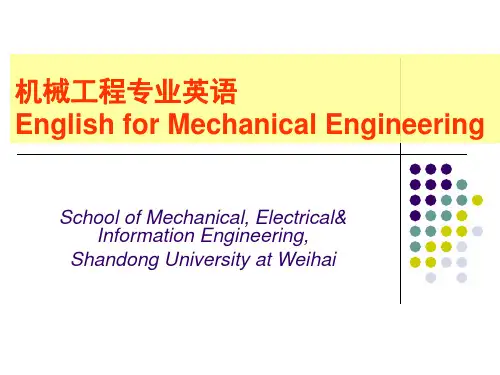
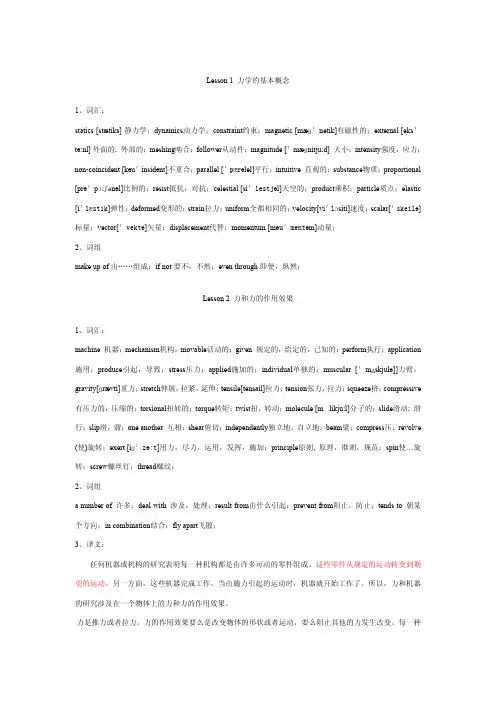
Lesson 1 力学的基本概念1、词汇:statics [stætiks] 静力学;dynamics动力学;constraint约束;magnetic [mæɡ'netik]有磁性的;external [eks'tə:nl] 外面的, 外部的;meshing啮合;follower从动件;magnitude ['mæɡnitju:d] 大小;intensity强度,应力;non-coincident [kəu'insidənt]不重合;parallel ['pærəlel]平行;intuitive 直观的;substance物质;proportional [prə'pɔ:ʃənəl]比例的;resist抵抗,对抗;celestial [si'lestjəl]天空的;product乘积;particle质点;elastic [i'læstik]弹性;deformed变形的;strain拉力;uniform全都相同的;velocity[vi'lɔsiti]速度;scalar['skeilə]标量;vector['vektə]矢量;displacement代替;momentum [məu'mentəm]动量;2、词组make up of由……组成;if not要不,不然;even through即使,纵然;Lesson 2 力和力的作用效果1、词汇:machine 机器;mechanism机构;movable活动的;given 规定的,给定的,已知的;perform执行;application 施用;produce引起,导致;stress压力;applied施加的;individual单独的;muscular ['mʌskjulə]]力臂;gravity[ɡrævti]重力;stretch伸展,拉紧,延伸;tensile[tensail]拉力;tension张力,拉力;squeeze挤;compressive 有压力的,压缩的;torsional扭转的;torque转矩;twist扭,转动;molecule [m likju:l]分子的;slide滑动; 滑行;slip滑,溜;one another 互相;shear剪切;independently独立地,自立地;beam梁;compress压;revolve (使)旋转;exert [iɡ'zə:t]用力,尽力,运用,发挥,施加;principle原则, 原理,准则,规范;spin使…旋转;screw螺丝钉;thread螺纹;2、词组a number of 许多;deal with 涉及,处理;result from由什么引起;prevent from阻止,防止;tends to 朝某个方向;in combination结合;fly apart飞散;3、译文:任何机器或机构的研究表明每一种机构都是由许多可动的零件组成。
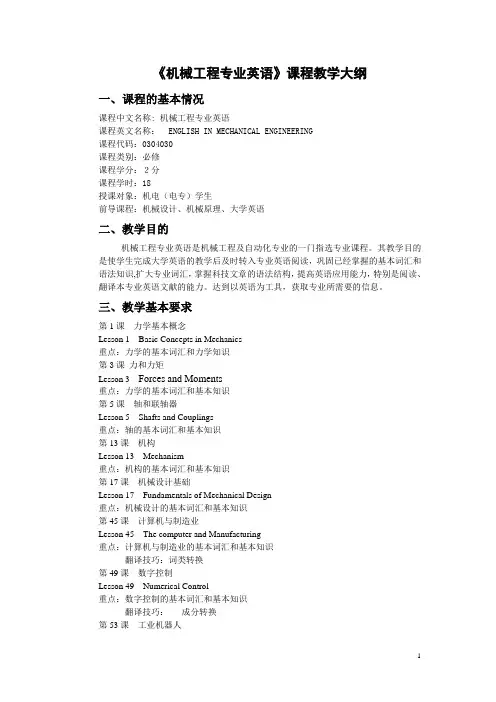
《机械工程专业英语》课程教学大纲一、课程的基本情况课程中文名称: 机械工程专业英语课程英文名称: ENGLISH IN MECHANICAL ENGINEERING课程代码:0304030课程类别:必修课程学分:2分课程学时:18授课对象:机电(电专)学生前导课程:机械设计、机械原理、大学英语二、教学目的机械工程专业英语是机械工程及自动化专业的一门指选专业课程。
其教学目的是使学生完成大学英语的教学后及时转入专业英语阅读,巩固已经掌握的基本词汇和语法知识,扩大专业词汇,掌握科技文章的语法结构,提高英语应用能力,特别是阅读、翻译本专业英语文献的能力。
达到以英语为工具,获取专业所需要的信息。
三、教学基本要求第1课力学基本概念Lesson 1 Basic Concepts in Mechanics重点:力学的基本词汇和力学知识第3课力和力矩Lesson 3 Forces and Moments重点:力学的基本词汇和基本知识第5课轴和联轴器Lesson 5 Shafts and Couplings重点:轴的基本词汇和基本知识第13课机构Lesson 13 Mechanism重点:机构的基本词汇和基本知识第17课机械设计基础Lesson 17 Fundamentals of Mechanical Design重点:机械设计的基本词汇和基本知识第45课计算机与制造业Lesson 45 The computer and Manufacturing重点:计算机与制造业的基本词汇和基本知识翻译技巧:词类转换第49课数字控制Lesson 49 Numerical Control重点:数字控制的基本词汇和基本知识翻译技巧:成分转换第53课工业机器人Lesson53 Industrial Robots重点:工业机器人的基本词汇和基本知识翻译技巧:掌握相应专业词汇第55课机器人系统的组成部分Lesson 55 Components of a Robot System重点:机器人系统的基本词汇和基本知识翻译技巧成分转换第57课工程师在机械制造业中的作用Lesson 57 The Roles of Engineers in Manufacturing重点:机械制造的基本词汇和基本知识翻译技巧状语从句的译法第59课信息时代的机械工程Lesson 59 Mechanical Engineering in the Information Age重点:机械工程的基本词汇和基本知识翻译技巧成分分译第61课如何撰写科学论文Lesson 61 How to Write a Scientific Paper重点:科学论文写作的基本词汇和基本知识翻译技巧长句分析四、课程内容与学时分配五、教材与参考书教材:《机械工程专业英语》,施平编,哈工大出版社,2007参考书:《机械工程英语》,陈道礼、刘旺、夏绪辉编,武汉科技大学机械自动化学院六、教学方式和考核方式1、教学方式:以课堂讲授为主,辅以课后作业。
![机械工程专业英语教程(第2版)[施平主编][翻译]_lesson1](https://uimg.taocdn.com/5728f673a417866fb84a8e09.webp)
Basic Concept in MechanicsThe branch of scientific analysis which deals with motions , time , and forces is called mechanics and is made up of two parts , statics and dynamics , Statics deals with the analysis of stationary systems , i.e. , those in which time is not a factor , and dynamics deals with systems which change with time .对运动、时间和作用力做出科学分析的分支称为力学。
它由静力学和动力学两部分组成。
静力学对静止系统进行分析,即在其中不考虑时间这个因素,动力学对随时间而变化的系统进行分析。
When a number of bodies are connected together to form a group or system , the forces of action and reaction between any two of the connecting bodies are called constraint forces . These forces constrain the bodies to behave in a specific manner . Forces external to this system of bodies are called applied forces .当一些物体连接在一起形成一个组合体或者系统时,任何两个相连接的物体之间的作用力和反作用力被称为约束力。
这些力约束着各个物体,使其处于特定的状态。
从外部施加到这个物体的系统的力被称为外力。
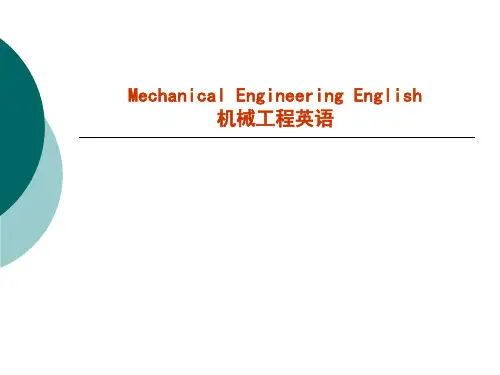
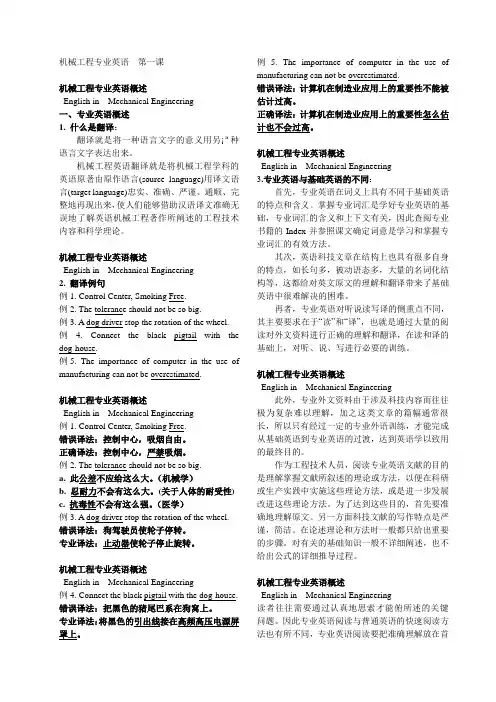
机械工程专业英语第一课机械工程专业英语概述English in Mechanical Engineering一、专业英语概述1. 什么是翻译:翻译就是将一种语言文字的意义用另¡ª种语言文字表达出来。
机械工程英语翻译就是将机械工程学科的英语原著由原作语言(source language)用译文语言(target language)忠实、准确、严谨、通顺、完整地再现出来,使人们能够借助汉语译文准确无误地了解英语机械工程著作所阐述的工程技术内容和科学理论。
机械工程专业英语概述English in Mechanical Engineering2. 翻译例句例1. Control Center, Smoking Free.例2. The tolerance should not be so big.例3. A dog driver stop the rotation of the wheel.例 4. Connect the black pigtail with the dog-house.例5. The importance of computer in the use of manufacturing can not be overestimated.机械工程专业英语概述English in Mechanical Engineering例1. Control Center, Smoking Free.错误译法:控制中心,吸烟自由。
正确译法:控制中心,严禁吸烟。
例2. The tolerance should not be so big.a. 此公差不应给这么大。
(机械学)b. 忍耐力不会有这么大。
(关于人体的耐受性)c. 抗毒性不会有这么强。
(医学)例3. A dog driver stop the rotation of the wheel.错误译法:狗驾驶员使轮子停转。
专业译法:止动器使轮子停止旋转。
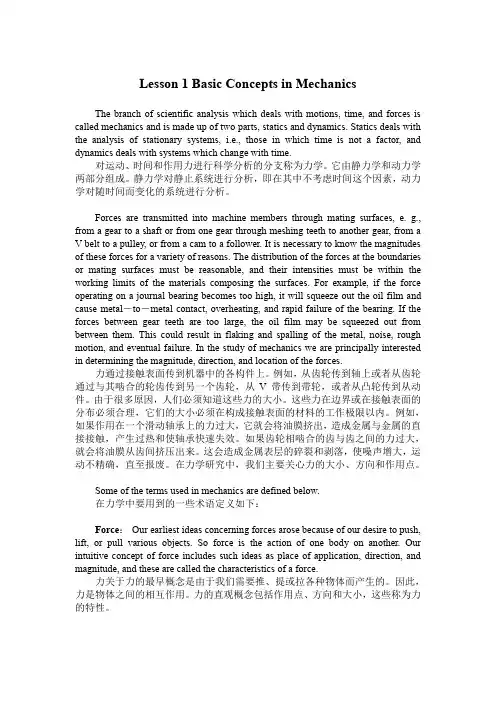
Lesson 1 Basic Concepts in Mechanics The branch of scientific analysis which deals with motions, time, and forces is called mechanics and is made up of two parts, statics and dynamics. Statics deals with the analysis of stationary systems, i.e., those in which time is not a factor, and dynamics deals with systems which change with time.对运动、时间和作用力进行科学分析的分支称为力学。
它由静力学和动力学两部分组成。
静力学对静止系统进行分析,即在其中不考虑时间这个因素,动力学对随时间而变化的系统进行分析。
Forces are transmitted into machine members through mating surfaces, e. g., from a gear to a shaft or from one gear through meshing teeth to another gear, from a V belt to a pulley, or from a cam to a follower. It is necessary to know the magnitudes of these forces for a variety of reasons. The distribution of the forces at the boundaries or mating surfaces must be reasonable, and their intensities must be within the working limits of the materials composing the surfaces. For example, if the force operating on a journal bearing becomes too high, it will squeeze out the oil film and cause metal-to-metal contact, overheating, and rapid failure of the bearing. If the forces between gear teeth are too large, the oil film may be squeezed out from between them. This could result in flaking and spalling of the metal, noise, rough motion, and eventual failure. In the study of mechanics we are principally interested in determining the magnitude, direction, and location of the forces.力通过接触表面传到机器中的各构件上。
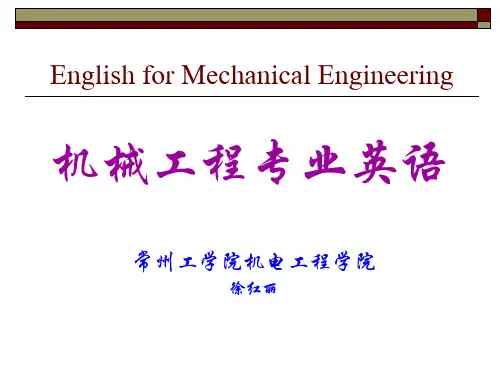
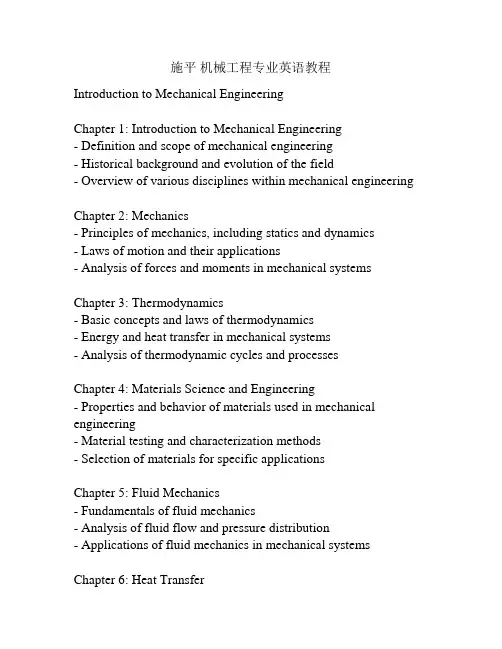
施平机械工程专业英语教程Introduction to Mechanical EngineeringChapter 1: Introduction to Mechanical Engineering- Definition and scope of mechanical engineering- Historical background and evolution of the field- Overview of various disciplines within mechanical engineering Chapter 2: Mechanics- Principles of mechanics, including statics and dynamics- Laws of motion and their applications- Analysis of forces and moments in mechanical systems Chapter 3: Thermodynamics- Basic concepts and laws of thermodynamics- Energy and heat transfer in mechanical systems- Analysis of thermodynamic cycles and processesChapter 4: Materials Science and Engineering- Properties and behavior of materials used in mechanical engineering- Material testing and characterization methods- Selection of materials for specific applicationsChapter 5: Fluid Mechanics- Fundamentals of fluid mechanics- Analysis of fluid flow and pressure distribution- Applications of fluid mechanics in mechanical systems Chapter 6: Heat Transfer- Modes of heat transfer (conduction, convection, radiation)- Heat transfer analysis and calculations- Applications of heat transfer in mechanical systemsChapter 7: Energy Conversion and Power Systems- Energy conversion principles and devices- Analysis of power generation systems- Renewable energy sources and sustainabilityChapter 8: Machine Design and Control Systems- Design principles and methodologies for mechanical systems- Control systems and automation in mechanical engineering- Analysis and optimization of machine componentsChapter 9: Manufacturing Processes- Various manufacturing processes and methodologies- Machining, forming, casting, and joining processes- Quality control and inspection in manufacturingChapter 10: Engineering Ethics and Professionalism- Ethical considerations in engineering practice- Professional responsibility and accountability- Society and the engineer's role in sustainable development Chapter 11: Career Opportunities in Mechanical Engineering- Overview of career options and paths in mechanical engineering - Skills and qualities desired by employers- Professional organizations and resources for career advancement Chapter 12: Emerging Technologies in Mechanical Engineering- Trends and developments in the field of mechanical engineering - Introduction to advanced technologies like robotics, nanotechnology, and artificial intelligence- Potential impact of these technologies on the future of mechanical engineering.。
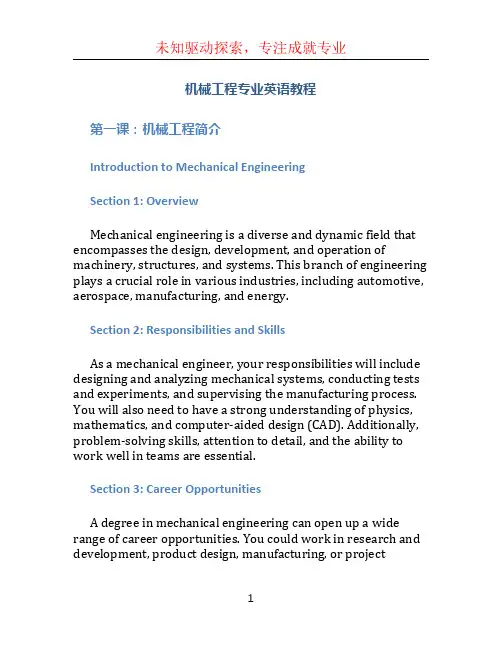
机械工程专业英语教程第一课:机械工程简介Introduction to Mechanical EngineeringSection 1: OverviewMechanical engineering is a diverse and dynamic field that encompasses the design, development, and operation of machinery, structures, and systems. This branch of engineering plays a crucial role in various industries, including automotive, aerospace, manufacturing, and energy.Section 2: Responsibilities and SkillsAs a mechanical engineer, your responsibilities will include designing and analyzing mechanical systems, conducting tests and experiments, and supervising the manufacturing process. You will also need to have a strong understanding of physics, mathematics, and computer-aided design (CAD). Additionally, problem-solving skills, attention to detail, and the ability to work well in teams are essential.Section 3: Career OpportunitiesA degree in mechanical engineering can open up a wide range of career opportunities. You could work in research and development, product design, manufacturing, or projectmanagement. Mechanical engineers are in demand in almost every industry, ensuring a stable and rewarding career path.Section 4: University CoursesTo become a mechanical engineer, it is essential to pursue a degree in mechanical engineering from a reputable university. The curriculum typically includes courses in engineering principles, materials science, thermodynamics, fluid mechanics, and mechanical design. Additionally, practical training through internships or cooperative education programs is crucial for gaining hands-on experience.Section 5: ConclusionMechanical engineering offers a challenging and rewarding career for those with a passion for solving problems and a desire to create innovative solutions. With the right education and skills, you can embark on a successful journey in the field of mechanical engineering. Remember, the possibilities are endless in this ever-evolving discipline.第二课:机械设计基础Fundamentals of Mechanical DesignSection 1: IntroductionIn this lesson, we will explore the fundamentals of mechanical design. Mechanical design involves the creation and development of physical systems and components that meet specific requirements and specifications. This processrequires a deep understanding of materials, mechanics, and engineering principles.Section 2: Design ProcessThe design process typically follows a systematic approach that includes several stages. These stages include problem identification, conceptual design, detailed design, manufacturing, and testing. Each stage involves various activities such as brainstorming, prototyping, and evaluation.Section 3: Design ConsiderationsDuring the design process, there are several important considerations to keep in mind. These include functionality, efficiency, reliability, safety, and cost-effectiveness. It is also crucial to consider the environmental impact and sustainability of the design.Section 4: Tools and SoftwareTo aid in the design process, engineers use various tools and software. Computer-aided design (CAD) software allows for precise modeling and simulation of mechanical systems. Finite element analysis (FEA) software helps in analyzing the structural integrity and performance of designs.Section 5: Case StudyTo further understand the application of mechanical design principles, we will examine a case study. This real-world example will demonstrate how the design process isimplemented to solve a specific problem and achieve desired outcomes.Section 6: ConclusionMechanical design is a critical aspect of mechanical engineering. It requires a combination of creativity, technical knowledge, and attention to detail. By mastering the fundamentals of mechanical design, you will be well-equippedto tackle complex challenges and contribute to the development of innovative solutions.以上是《机械工程专业英语教程》的课文翻译。
Lesson1 the mechanical design process 1, the mechanical design processThe ultimate objective of mechanical design is to produce a useful product that satisfies the needs of a customer and that is safe ,efficient, reliable, economical, and practical to manufacture .think broadly when answering the question ,”who is the customer for the product or system I am about to design?”it is essential that you know the desires and expectations of all customers before product design. marketing professionals are often employed to manage the definition of customer expectations , but designers will likely work with them as a part of a product development team .many methods are used to determine what the customer wants. One popular method , called quality function deployment or QFD , seeks(1) to identify all of the features and performance factors that customers desire and (2) to assess the relative importance of these factors. the result of the QFD process is a detailed set of functions and design requirements for the product.It is also important to consider how the design process fits with all functions that must happen to deliver a satisfactory product to the customer and to service the product throughout its lift cycle. in fact, it is important to consider how the product will be disposed of after it hasserved its useful life . the total of all such function that affect the product is sometimes called the product realization process or PRP . some of the factors included in PRP are as follows:1 marketing functions to assess customer requirements2 research to determine the available technology that can reasonably be used in the product3 availability of materials and components that can be incorporated into the product4 product design and development5 performance testing6 documentation of the design7 vendor relationships and purchasing functions8 work-force skills9 physical plant and facilities available10 capability of manufacturing systems11production planning and control of production systems12production support systems and personnel13 quality systems requirements14 sales operations and time schedules15 cost targets and other competitive issues16 customer service requirements17 environmental concerns during manufacture , operation anddisposal of the product18 legal requirements19 availability of financial capitalCan you add to this list? You should be able to see that the design of a product is but one part of a comprehensive process. in this text, we will focus more carefully on the design process itself , but the producibility of designs must always be considered . this simultaneous consideration of product design and manufacturing process design is often called concurrent engineering.2 skills needed in mechanical designProduct engineers and mechanical designers use a wide range of skills and knowledge in their daily work . these skills and knowledge are included in the following :1sketching, technical drawing , and computer-aided design2 properties of materials, materials processing, and manufacturing processes3 applications of chemistry, such as corrosion protection, plating , and painting4 statics, dynamics, strength of materials , kinematics, and mechanisms5 fluid mechanics, thermodynamics, and heat transfer6 fluid power, the fundamentals of electrical phenomena, andindustrial controls7 experimental design and performance testing of materials and mechanical systems8 stress analysis9 specialized knowledge of the behavior of machine elements, such as gears, belt drives, chain drives, shafts, bearings, keys, splines, couplings, seals, spring, connections(bolted, riveted, welded, adhesive), electric motors, linear motion devices, clutches, and brakes10 creativity , problem solving ,and project management11 oral communication, listening, technical writing, and teamwork skills3 functions , design requirements and evaluation criteriaSection 1 emphasized the importance of carefully identifying the needs and expectations of the customer prior to beginning the design of a mechanical device. you can formulate these by producing clear , complete statements of functions, design requirements , and evaluation criteria:1 Functions tell us what the device must do , using general , nonquantitative statements that employ action phrases such as “to support a load”, “to lift a crate ”, “to transmit power”, or “to hold two structural members together”, etc2 Design requirements are detailed, usually quantitativestatements of expected performance levels, environmental conditions in which the device must operate, limitations on space or weight , or available materials and components that may be used3 Evaluation criteria are statements of desirable qualitative characteristics of a design that assist the designer in deciding which alternative design is optimum-that is , the design that maximizes benefits while minimizing disadvantagesTogether these elements can be called the specifications for the designMost designs progress through a cycle of activities are outlined in figure1.1. you should typically propose more than one possible alternative design concept. This is where creativity is exercised to produce truly novel designs .Each design concept must satisfy the functions and design requirements . a critical evaluation of the desirable features, advantages, and disadvantages of each design concept should be completed . then a rational decision analysis technique should use the evaluation criteria to decide which design concept is the optimum and , therefore , should be produced.Reading materialMechanical design is the process of designing and/or selecting mechanical components and putting them together to accomplish a desired function. Of course machine elements must be compatible ,must fit well together , and must perform safely and efficiently. The designer must consider not only the performance of the element being designed at a given time , but also the elements with which it must interface.To illustrate how the design of machine elements must be integrated with a larger mechanical design , let us consider the design of a speed reducer for the small tractor . suppose that,to accomplish the speed reduction ,you decide to design a double-reduction, spur gear speed reducer. You specify four gears , three shafts , six bearings, and a housing to hold the individual elements in proper relation to each other. The primary elements of the speed reducer are :1 the input shaft is to be connected to the power source, a gasoline engine whose output shaft rotates at 2000 rpm . a flexible coupling is to be employed to minimize difficulties with alignment .2 the first pair of gears, a and b ,causes a reduction in the speed of the intermediate shaft proportional to the ratio of the numbers of teeth in the gears. Gear b and c are both mounted to intermediate shaft and rotate at the same speed .3 a key is used at the interface between the hub of each gear and the shaft on which it is mounted to transmit torque between the gear and the shaft .4 the second pair of gears , c and d ,further reduces the speed of gear d and the output shaft to the range of 290 rpm to 295 rpm .5 the output shaft is to carry a chain sprocket.the chain drive ultimately is to be connected to the drive wheel of the tractor.6 each of the three shafts is supported by two ball bearings .making them statically determinate and allowing the analysis of forces and stresses using standard principles of mechanics.7 the bearings are held in a housing that is to be attached to the frame of the tractor . note the manner of holding each bearing so that the inner race rotates with the shaft while the outer race is held stationary.8 seals are on the input and output shafts to prohibit contaminants from entering the housing .9 details of how the active elements are to be installed , lubricated, and aligned are only suggested at this stage of the design process to demonstrate feasibility .one possible assembly process could be as follows.Start by placing the gearing the gears, keys, spacers, and bearings on their respective shaftsThen insert input shaft into its bearing seat on the left side of the housing.Insert the left end of intermediate shaft into its bearing seat whileengaging the teeth of gears a and b.Install the center bearing support to provide support for the bearing at the right side of input shaft.Install output shaft by placing its left bearing into the seat on the center bearing support while engaging gears c and d.Install the right side cover for the housing while placing the final two bearings in their seats.Ensure careful alignment of the shafts.Place gear lubricant in the lower part of housing .The arrangement of the gears, the placement of the bearings so that they straddle the gears , and the general configuration of the housing are also design decisions . the design process cannot rationally proceed until these kinds of decisions are made . when the overall design is conceptualized, the design of the individual machine elements in the speed reducer can proceed . you should recognize that you have already made many design decisions by rendering such a sketch . first, you choose spur gears rather than helical gears , a worm and worm gear , or bevel gears. in fact , other types of speed reduction devices –belt drives , chain drives, or many others—could be appreciate.1gearsfor the gear pairs ,you must specify the number of teeth in each gear ,the pitch (size) of the teeth , the pitch diameters, the face width ,and the material and its heat treatment . these specifications depend on considerations of strength and wear of the gear teeth and the motion requirements(kinematics ). You must also recognize that the gears must be mounted on shafts in a manner that ensures proper location of the gears, adequate torque transmitting capability from the gears to the shafts (as through keys ) and safe shaft design.2shaftshaving designed the gear pairs, next you will consider the shaft design . the shaft is loaded in bending and torsion because of the forces acting at the gear teeth . thus, its design must consider strength and rigidity , and it must permit the mounting of the gears and bearings . shafts of varying diameters may be used to provide shoulders against which to seat the gears and bearings. There may be keyseats cut into the shaft, the input and output shafts will extend beyond the housing to permit coupling with the engine and the drive axle . the type of coupling must be considered, as it can have a dramatic effect on the shaft stress analysis. Seals on the input and output shafts protect internal components.3bearingsdesign of the bearings is next. If rolling contact bearings are to be used , you will probably select commercially available bearings from a manufacturer’s catalog , rather than design a unique one . you mustfirst determine the magnitude of the loads on each bearing from the shaft analysis and the gear designs. The rotational speed and reasonable design life of the bearings and their compatibility with the shaft on which they are to be mounted must also be considered. For example , on the basis of the shaft analysis, you could specify the minimum allowable diameter at each bearing seat location to ensure safe stress levels . the bearing selected to support a particular part of the shaft ,then , must have a bore( inside diameter) no smaller than necessary. When a specific bearing is selected , the shaft at the bearing seat location and allowable tolerances must be specified ,according to the bearing manufacturer’s recommendations , to achieve proper operation and life expectancy of the bearing.。
LESSON 1 Classification of Engineering MaterialsNonferrous Metal elements other than iron called nonferrous metals.有色金属元素和像铁一样的有色金属不同。
The nonferrous subgroup includes common lightweight metals such as titanium and beryllium and common heavier metals such as copper, lead, tin and zinc.有色金属包括常用的轻金属,比如钛和铍,还有常见的重金属比如铜,铅,锡和锌。
Among the heavier metals is a group of white metals, including tin, lead, and cadmium; they have lower melting, about 230 to 330.在常用的重金属中,比如锡,铅和镉。
它们的熔点较低,一般是230到330摄氏度。
Among the high temperature nonferrous metals are molybdenum, niobium, tantalum, and tungsten. 高温有色金属包括钼,铌,钽和钨。
Tungsten has the highest melting of all metals: 3400 centigrade. Metal alloys other than iron are called nonferrous alloys are practically endless.钨在所有金属中具有最高的熔点,达到了3400摄氏度。
事实上金属合金远不同于有色金属合金。
Powdered Metals alloying of metals involves melting the main ingredients together so that on cooling, the metal alloy is generally a nonporous solid.粉末合金金属是通过熔化主要金属元素并结合在一起,然后让他们冷却而形成的,金属合金一般是无孔隙固体。